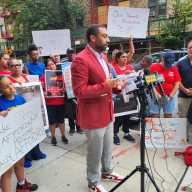With all the new development that is happening in the Bronx over the last decade, one community has sought to take back its neighborhood.
In April of 2017, Design Trust for Public Space sent out an open call for “project ideas to ensure New York City’s public realm remains truly public.”
Called Public for All: Rethinking Shared Space in NYC, Design Trust selected two out of the 105 project proposals they received.
One of these proposals was Community Land Trust as a Model for Public Space by South Bronx Unite in collaboration with New York City Community Land Initiative and the Mott Haven-Port Morris Community Land Stewards.
This project, officially called Power in Place: Building Community Wealth and Well-Being in Mott Haven-Port Morris, was officially launched on Saturday, December 2 at a kickoff event in the Hub.
The kickoff event informed community members of the project, as well as call for others to join the effort.
“We formed our Community Land Trust as the natural opposing force to hyper real estate speculation and displacement and to make sure that our community could continue to exist in our community,” said Mychal Johnson, a founding member of SBU and a 15-year resident of Mott Haven.
The waterfront neighborhood has suffered from many environmental impediments such as industrial waste transfer stations and diesel truck-intensive businesses in the area, they pointed out.
These businesses have caused pollution and health concerns for the community, which has asthma rates eight times the national average, according to organizers.
In addition, 12 market-rate rentals and six hotel developments have been announced or are in some phase of construction establishing thousands of luxury dwellings in the area where the average median income is $19,454, the lowest in the state, according to SBU.
“We see market-rate housing being built in our community that will require our low income families to earn four to seven times as much as they currently earn to be able to afford to live in these developments,” Johnson explained. “We see that as a potential for displacement.”
The Power in Place project will use a Community Land Trust to identify places in the neighborhood, like empty lots or abandoned or vacated properties that can be used for community needs like recreation, education or health.
“We want to make sure that the community has a place to live in the area and a place to continue to work in the area,” said Samira Behrooz, a program manager working on Power in Place for Design Trust for Public Space. “If they want to change their neighborhood they have a voice and they have a say in what that change will look like.”
As an example of asset-mapping for Power in Place, SBU identified a property located at 349 E. 140th Street, which has been vacant for five years.
Though the building is owned, the group has pitched trying to repurpose the property to create a heart center.
The team is expected to begin full project activities in January 2018.
For more information or how to get involved in the Power in Place project, contact Mychal Johnson, mycha





















